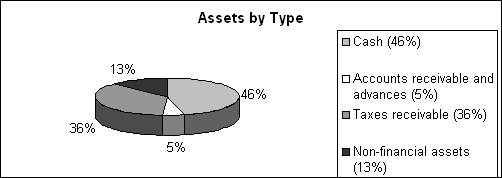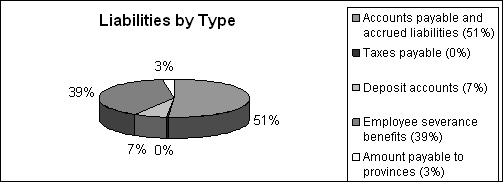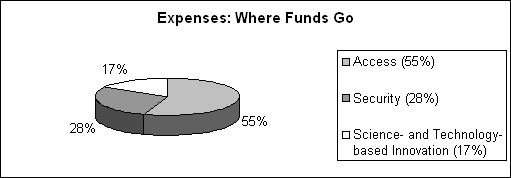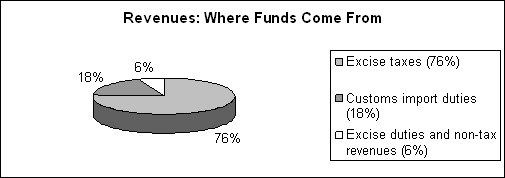Common menu bar links
Breadcrumb Trail
ARCHIVED - Canada Border Services Agency
 This page has been archived.
This page has been archived.
Archived Content
Information identified as archived on the Web is for reference, research or recordkeeping purposes. It has not been altered or updated after the date of archiving. Web pages that are archived on the Web are not subject to the Government of Canada Web Standards. As per the Communications Policy of the Government of Canada, you can request alternate formats on the "Contact Us" page.
Section III: Supplementary information
Internal Services
The CBSA's Internal Services program activity focuses on the ongoing implementation of a modern management regime that is results-based, delivers value for money and, through a regular process of monitoring, allocates or reallocates resources to the Agency's priorities. The CBSA is reporting on its Internal Services activities in 2008‑09 because Internal Services was included in the Agency's 2008‑09 Report on Plans and Priorities.
Performance Analysis
Human Resources
The CBSA strives to ensure that its human resources regime meets the business needs of the Agency, complies with government-wide requirements and provides timely and efficient human resources services to its employees.
Meeting Our 2008‑09 Commitments
- The human resources strategic plan was updated to address identified challenges to ensure that the CBSA's workforce is representative of the Canadian population and the plan was shared with employees.
- The Strategic Learning Direction for 2008‑11 was completed and it links the CBSA's training priorities with the Agency's business priorities.
- The Leadership Learning Framework initiative was launched, which includes developing leadership learning products and tools for CBSA managers and exploring new ways to recruit and train employees.
- Over 1,000 new border services officers were recruited.
- 923 new border services officers and 444 veteran CBSA employees were trained in the three program areas of the CBSA's mandate (customs; immigration; food, plant and animal inspection).
Informal Conflict Management System and Values and Ethics
The Informal Conflict Management System team continued its collaborative efforts to promote the fair and effective resolution of conflict at the CBSA. The primary focus in 2008‑09 was on program and policy development. Notable achievements included increasing mediation capacity and designing a new performance measurement and reporting tool. The proactive approach to informal conflict management skill building and awareness resulted in 71 rights-based recourses being averted or withdrawn.
The CBSA's values and ethics team designed, developed and delivered values and ethics sessions tailored to different levels of management and staff. In 2008‑09, 35 one-day sessions on values, ethics and disclosure of wrongdoing were delivered in regional offices and attended by 540 employees and managers. The sessions included specific information on the provisions and requirements of the Public Servants Disclosure Protection Act and on internal disclosure procedures at the CBSA. Critical thinking tools to help prevent unethical behaviour in the workplace were also provided.
Risk Management
In 2008‑09, key activities to implement a modern management regime at the CBSA included the development of an Integrated Risk Management Framework. While the Framework is designed primarily to identify and assist in the mitigation of corporate risks, it will also help the Agency deal effectively with operational threats and risks. This is consistent with the recommendations made in the 2007 October Report of the Auditor General of Canada, Chapter 5, “Keeping the Border Open and Secure.”
Performance Measurement
In 2008‑09, an executive dashboard was piloted to provide senior managers with the data they need to stay apprised of the Agency's performance and to make course adjustments as needed. The dashboard contains a small number of key performance indicators that reflect corporate management concerns (e.g. the enterprise risk profile) and how the Agency demonstrates and reports on its performance to others (e.g. Parliament, the Office of the Auditor General of Canada and the Treasury Board of Canada Secretariat). The development of additional informative indicators is ongoing and, when completed, will result in an inventory of indicators to help measure the performance of the Agency's various programs and services. The CBSA has also taken steps to establish performance targets for areas such as the management of warrants in the Intelligence program and will continue to establish targets for other programs throughout 2009‑10.
The Agency's performance measurement framework was not completed in 2008‑09 due to the need to further revise the CBSA's Program Activity Architecture. The CBSA has committed to developing a more robust Program Activity Architecture and a revised performance measurement framework for 2011‑12.
Facilities
To ensure that the Agency has sufficient space to accommodate existing staff and its planned workforce for the next three years, the CBSA undertook a review of its long-term accommodation strategy, which is now being finalized. The strategy includes consolidating headquarters in a campus of new buildings, and a site was secured by Public Works and Government Services Canada in early 2009.
New port-of-entry facilities at Douglas, British Columbia, were completed in September 2008. Port infrastructure at St. Stephen, New Brunswick, was completed on schedule and will be operational when the new international bridge is opened to traffic in the second half of 2009. Budget 2009 identified additional funds for the expansion and modernization of border facilities at Prescott (Ontario) and at Kingsgate, Pacific Highway and Huntingdon (all in British Columbia).
Over the next five years, 15 to 20 small port-of-entry facilities will be replaced. The development of a standard small-port template design has been completed, and advance site surveys on many of the proposed locations will be completed in 2009‑10.
Financial Highlights
| Condensed Statement of Financial Position For the period ending March 31, 2009 |
Percentage Change | 2009 | 2008 |
|---|---|---|---|
| Financial assets | -15.87 | 2,566,532 | 3,050,710 |
| Non-financial assets | 14.33 | 391,076 | 342,051 |
| Total assets | -12.83 | 2,957,608 | 3,392,761 |
| Total liabilities | -76.31 | 537,559 | 2,268,884 |
| Total equity | 115.33 | 2,420,049 | 1,123,877 |
| Total liabilities and equity | -12.83 | 2,957,608 | 3,392,761 |
| Condensed Statement of Financial Position For the period ending March 31, 2009 |
Percentage Change | 2009 | 2008 |
|---|---|---|---|
| Total expenses | 19.85 | 1,866,659 | 1,557,505 |
| Tax revenues | -8.50 | 22,622,415 | 24,724,683 |
| Non-tax revenues | 29.57 | 100,844 | 77,828 |
| Total revenues | -8.38 | 22,723,259 | 24,802,511 |
| Net results | -10.27 | 20,856,600 | 23,245,006 |
Financial Highlights Charts

The CBSA's total assets were $2.958 billion at the end of 2008‑09, a decrease of $435 million (or -13 percent) over the total assets of $3.393 billion for 2007‑08. Financial assets (cash, accounts receivable and advances, and taxes receivable) represent the largest portion at $2.567 billion or 87 percent of total assets.

Total liabilities were $538 million at the end of 2008‑09, a decrease of $1.731 billion (76 percent) over the total liabilities of $2.269 billion for 2007‑08. Accounts payable and accrued liabilities represent the largest portion of liabilities at $276 million or 51 percent of total liabilities.

Total expenses were $1.867 billion for 2008‑09, an increase of $309 million (19.85 percent) over the total expenses of $1.558 billion for 2007‑08. The majority of the funds, $1.022 billion (or 55 percent), was spent on the Access program activity; $518 million or 28 percent of total expenses was spent on the Security program activity.

The Agency's total revenues were $22.723 billion for 2008‑09, a decrease of $2.08 billion (or -8 percent) over the total revenues of $24.803 billion for 2007‑08. Excise taxes (goods and services tax/harmonized sales tax, gas, etc.) represent the majority of revenues at $17.348 billion or 76 percent of total revenues. Customs import duties represent a significant portion of revenues at $4.036 billion or 18 percent of the total revenues.
Financial Statements
The CBSA's financial statements are available on the Agency's Web site at http://www.cbsa-asfc.gc.ca/agency-agence/reports-rapports/menu-eng.html.
List of Online Tables
All supplementary information tables of the 2008‑09 Departmental Performance Report can be found on the Treasury Board of Canada Secretariat's Web site at http://www.tbs-sct.gc.ca/.
Table 1: Sources of Respendable and Non-Respendable Revenue
Table 2: User Fees/External Fees
Table 3: Details on Project Spending
Table 4: Status Report on Major Crown Projects
Table 5: Horizontal Initiatives
Table 6: Sustainable Development Strategy
Table 7: Green Procurement
Table 8: Response to Parliamentary Committees and External Audits
Table 9: Internal Audits and Evaluations
Information and Contacts
To contact the CBSA and for more information on its activities, please visit the CBSA's Web site at http://www.cbsa-asfc.gc.ca. Links to other Web sites of interest are provided below.
Canada Revenue Agency
http://www.cra-arc.gc.ca
Canadian Food Inspection Agency
http://www.inspection.gc.ca
Canadian Security Intelligence Service
http://www.csis.gc.ca
Citizenship and Immigration Canada
http://www.cic.gc.ca
Department of Finance Canada
http://www.fin.gc.ca
Foreign Affairs and International Trade Canada
http://www.international.gc.ca
Health Canada
http://www.hc-sc.gc.ca
Public Safety Canada
http://www.publicsafety.gc.ca
Royal Canadian Mounted Police
http://www.rcmp-grc.gc.ca
Transport Canada
http://www.tc.gc.ca
